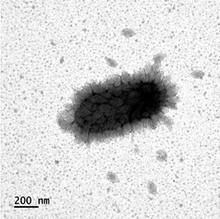| Nitrosopumilus | |
|---|---|

| |
| Nitrosopumilus maritimus, partially with virions of Nitrosopumilus spindle-shaped virus 1 (Thaspiviridae) attached. | |
| Scientific classification | |
| Domain: | |
| Phylum: | |
| Class: | |
| Order: | |
| Family: | |
| Genus: | Nitrosopumilus Qin et al. 2017
|
| Type species | |
| Nitrosopumilus maritimus Qin et al. 2017
| |
| Species | |
| |
| Synonyms | |
| |
Nitrosopumilus is a genus of archaea. The type species, Nitrosopumilus maritimus, is an extremely common archaeon living in seawater. It is the first member of the Group 1a Nitrososphaerota (formerly Thaumarchaeota) to be isolated in pure culture. Gene sequences suggest that the Group 1a Nitrososphaerota are ubiquitous with the oligotrophic surface ocean and can be found in most non-coastal marine waters around the planet.[1] It is one of the smallest living organisms at 0.2 micrometers in diameter. Cells in the species N. maritimus are shaped like peanuts and can be found both as individuals and in loose aggregates.[2] They oxidize ammonia to nitrite and members of N. maritimus can oxidize ammonia at levels as low as 10 nanomolar, near the limit to sustain its life.[3] Archaea in the species N. maritimus live in oxygen-depleted habitats. Oxygen needed for ammonia oxidation might be produced by novel pathway which generates oxygen and dinitrogen.[4] N. maritimus is thus among organisms which are able to produce oxygen in dark.
This organism was isolated from sediment in a tropical tank at the Seattle Aquarium by a group led by David Stahl (University of Washington).[5]
- ^ Walker, C. B.; de la Torre, J. R.; Klotz, M. G.; Urakawa, H.; Pinel, N.; Arp, D. J.; Brochier-Armanet, C.; Chain, P. S. G.; Chan, P. P. (11 May 2010). "Nitrosopumilus maritimus genome reveals unique mechanisms for nitrification and autotrophy in globally distributed marine crenarchaea". Proceedings of the National Academy of Sciences of the United States of America. 107 (19): 8818–8823. Bibcode:2010PNAS..107.8818W. doi:10.1073/pnas.0913533107. ISSN 1091-6490. PMC 2889351. PMID 20421470.
- ^ Ko ̈nneke; Bernhard; de la Torre; Walker; Waterbury; Stahl (2005). "Isolation of an autotrophic ammonia-oxidizing marine archaeon". Nature. 437 (7058): 543–546. Bibcode:2005Natur.437..543K. doi:10.1038/nature03911. PMID 16177789. S2CID 4340386.
- ^ http://www.physorg.com/news173538255.html Planet's nitrogen cycle overturned by 'tiny ammonia eater of the seas' Hannah Hickey 2009-09-30 originally based on a Nature publication by Willm Martens-Habbena, David Stahl
- ^ Kraft, Beate; Jehmlich, Nico; Larsen, Morten; Bristow, Laura A.; Könneke, Martin; Thamdrup, Bo; Canfield, Donald E. (7 January 2022). "Oxygen and nitrogen production by an ammonia-oxidizing archaeon". Science. 375 (6576): 97–100. doi:10.1126/science.abe6733. ISSN 0036-8075.
- ^ Könneke, Martin; Bernhard, Anne E.; de la Torre, José R.; Walker, Christopher B.; Waterbury, John B.; Stahl, David A. (22 September 2005). "Isolation of an autotrophic ammonia-oxidizing marine archaeon". Nature. 437 (7058): 543–546. Bibcode:2005Natur.437..543K. doi:10.1038/nature03911. PMID 16177789. S2CID 4340386.